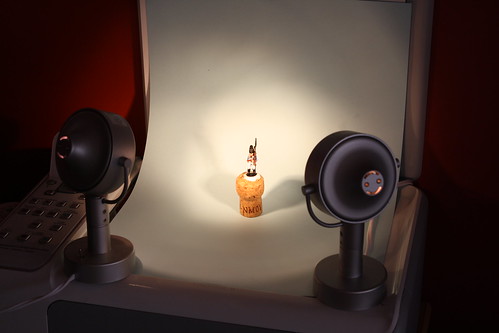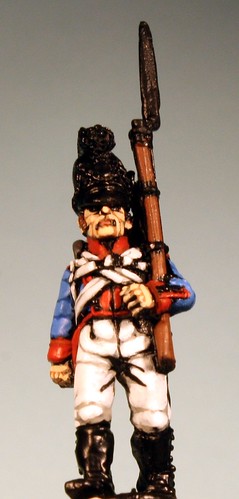As others will agree with me, the most important thing when photographing miniatures is not the camera or the post processing software, but simply light - the bunch of photons of various frequencies that bounce off of (or are absorbed and re-emitted at a different frequency by) the miniature and are captured on the camera's CCD (or film if you're inclined towards the analog side of photography). Specifically, one can never have enough of it. By far the most common 'mistake' in photographs of miniatures (including many of my own) is that there was not enough light when they were taken.
Now, if you're lucky, you can use daylight for your photographs, but you need good daylight. Diffuse, uniform and stable daylight. Hard, direct sunlight means harsh shadows and part of your miniature invisible in the shadows. As most of us work during the day, the only time we have for photographing miniatures is evenings, and it tends to be dark around then. Especially if you're anything like me and want to show off a freshly painted miniature when it is still that - so freshly painted that the paint is not completely dry yet. And as miniatures tend to be finished at the end of painting sessions, it is invariably late at night and dark at that time -- so no sunlight.
The second option is coming up with some kind of 'studio' setup where you have a number of lights shining on the miniature to be photographed. Over the years, I've had lots of setups, but they all suffered from the fact that they need some time to piece together. I have to clear the painting table, find a way to prop up the background paper, find and set up the lights, place the miniature, .... Too involved, which means that often I did not bother and settled for lesser quality photographs.
However, today I stumbled upon the (for now) perfect combination of ease and convenience -- my scanner (well, actually all-in-one printer). I can use the scanner bed as my 'studio', and the scanner lid hinges open to support the A3 paper I use as a background. Add two spots and the studio is done! Just put the camera on a tripod in front of it and we're done! The entire thing (as the spots live next to the printer when not in use) sets up in no time at all. Here's a photo of the thing in use:

And here's the result, with only the white balance adjusted (the light of those spots is very yellow):

So next time I'll have to set the white balance manually before taking the photograph (so I don't need to do it in a photo editing program afterwards) and I also think I'll lift the camera up a bit higher, as now it photographs from just below the miniature instead of head on - and you start to see the shortcuts I take to paint the miniature fast that way :). BTW, the fusilier in the photograph is still a work in progress - the metals, musket and black still need to be finished.
The final step in lighting for miniature photography is a light tent, of course. Maybe that's next :)

No comments:
Post a Comment